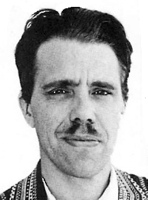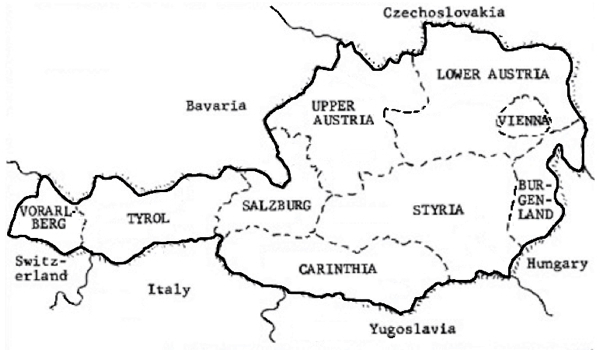
|
The Society of Folk Dance Historians (SFDH)
Austrian Dance
[
Home |
About |
Encyclopedia | CLICK AN IMAGE TO ENLARGE |

|
Folk dance and folklore have a very ancient heritage in Austria, tucked away among the hills, the mountains, and the valleys of West Central Europe. Surrounded on three sides by non-German-speaking peoples, some of which were, until 1918, part of the Austro-Hungarian Empire, the country has, while adopting some of the customs and culture of its neighbors, perhaps exported more of its own to them. Notable among these exports was the world's favorite dance, the Viennese Waltz.
There was a period in Austrian history when folk culture wsa in eclipse, roughly corresponding to the Victorian Age in Great Britain and continuing through to the end of World War I, when the country was prosperous, and the aura of the Blue Danube and the Viennese Woods filled the land. Franz Joseph was the Emperor – a contemporary of England's Victoria, and Austria-Hungary, more than other European nation, followed along (or led as the case may be) in matters cultural, artistic, and in the Courts, of those elegant days. The fashions of Vienna set the style, and peasant clothes were readily exchanged for the latest modes when affordable.

|
Music, dance, and handicrafts likewise faltered – faltered, but did not disappear to the extent that they did in England. The valleys and the mountains and the rushing rivers helped to create insularity all over the land, and the older people among the citizens retained their ways, and in good Germanic tradition and custom, jotted down notes. This is in reference to Austria proper, of course, those territories of the Empire with radically different backgrounds and languages, such as Bohemia, Moravia, Slovenia, Bosnia, Hungary, etc. that we don't consider as Austria, and they were separated from the Empire following the first World War.
It was as early as 1885 that some few wise ones saw the trending away from tradition, and began to make efforts to keep Austrian culture from completely disappearing. By the early years of the 20th century, they had started to encourage the peasants to hold onto their tradition and others to return and take up where they had once left, not physically and literally, of course, but in a spirit of nationalism. This "national" spirit was somewhat difficult to understand when the Austrian core was only a fraction of the population of diverse Empire nationalities. With the break-up in 1918, the term "Austrian" was much easier to comprehend. True Austria then became aware of ancient peasant traditions, music, dance – old costumes and garments began to come out of garrets, chests, trunks – the men fashioned lederhosen for wear at kermesse (festival) and feast days, and the people went to the homes of the old men and women who could remember the dances and asked them how they were done. Austria had gone in for dance and folk music research. Perhaps there was also a little bit more to it than pure nationalism. A country very rich in historical sites, churches, castles, edifices, spas, festivals, musical events, magnificent peasant life – and tourism being a big part of the national economy – the regeneration of folk dance, custom, and dress was especially accelerated.
There is a great variety of recreational and ritual dance in Austria. Many of the latter have survived or been restored from pagan times and the period of the Middle Ages. Some of these ritual dances are remarkably exciting, and because of their nature, are done only on the dates of the period of the occasion – mostly during the period of Carnival. (Carnival, generally looked on as a Latin American and Southern European event, is a major holiday in Austria, though no means as lengthy as in Rio or Trinidad, etc.)
Referring to Katharina Breuer's "Dances of Austria," there are several of the sword-dance types performed on special days. The salt-miner's dance from Hallein on the Bavarian border in Salzburg is over 300 years old. Sixteen to twenty men dance in their mining clothes – white jackets and dark trousers, with red sashes round their waists. They dance, in typical European sword-link-up formation, and execute manuvers depicting their work in the salt mines. A flag is waved aloft at the conclusion of the dance. Other sword dances of similar nature are done in towns and villages of Upper and Lower Austria and Styria. There also are the Garland Dances, utilizing similar figure-patterns. Some of these were adopted by the trades and crafts guilds and became very elaborate while others remain in the villages in pure rustic style. Like so many of the European dances, they include the Fool, the masques, the animals – bear, goat, horse, and so on – most of which can be traced back to pre-Christian ritual.
Then there are the Schemen or ghost-dramas – processions and dance forms that appear during the Carnival season. Some of these dances portray evil spirits who return to their home villages to do harm, while other good spirits pursue them to do good and protect the villagers and their fields and crops from the evil ones. There also are the Perchten, another group of good and evil. The evil of the Perchten (or Berchten) were said to have their homes high in the peak of Berchtesgaden – which in view of the fact that Eyrie was the retreat of the most notorious personification of evil of all time around 1941, is rather a point to ponder. Anyhow, the Perchten dancers wear many masks, carry big Alpine cowbells which ring as they dance. Some wear headdresses six feet high or more, decorated with mirrors, flowers, and jewelry. There are sometimes two groups – the Schoene (pretty) and the Schieche (ugly), and these latter strive to outdo each other with the most horrible and terrifying masks. Coming in the spring and late winter, as most of these dances do, they apparently originate from ancient fertility and planting rites.
In the category of ritual dances one could include the numerous wedding dances. It was quite a tradition to present the bride to the groom amid dancing, and this took place in the church also, at least up until the 16th century. There was nothing wrong in celebrating within the church for it represented a joyous and proper occasion – the sacrament of marriage. One of the best known wedding dances is the Bandltanz which is a ribbon dance somewhat similar to a Maypole dance. Processionals and dances related to the harvesting of the crops and the gathering of the grapes called after the location or the crop may be found all over Austria. Breuer gives the vintage festivals of the beautiful Grinzing vale and Nussberger, and the church-day feast Kufenstachen from the Gailtal. Here one finds a cavalcade on horseback along with the songs and dances. This celebration, a dance-break from work, takes place in the late fall, and afterwards, there is no more dancing until spring.
As folk dancers in America have noticed, most of the dances learned in the institutes, camps, and from teachers specializing in dances of Austria. They are in 2/4 or 3/4 time, but some are in 4/4 time. This polka and waltz rhythm dated from the early 19th century. The Lündler is a wide family, and includes among its members, the Austrian Schuhplattler. These generally come from the Tyrol and Salzberg provinces, nearer to the Bavarian border. The Steirischer Lündlers come from the province of Styria, and borders on Slovenia and Hungary. There is a very strong similarity in the music, dance steps, and even the dress of Slovenia and the eastern Austrian provinces. A usual sequence is to dance the turning and twisting pattern for the 8, 16, or 24 measures, then march in the circle or in toward the center, clapping an singing. Singing is important – most of the Austrian dances, which Morry Gelman taught at the 1981 summer folk dance camps, had songs to accompany the movements, and the songs were as much a part of the dances as the footwork and the intricate arm-twining itself.
Sometime in the early 19th century, the 3/4 dance time of the dance changed to 4/4 time, and this in the province of Upper Austria became known as Lăndler (from "das lăndl" – the little country). The 3/4 dance went on into Vienna, carried by the musicians on the Danube River barges, and by leaving out the twisting and turning convolutions of the arms and hands, the Viennese developed the Viennese Waltz. And here is a rather strange situation – for a while it was apparently okay for a man and a girl to indulge in all the weaving and squirming involved in the dances we know as a Dreisteyrer or Steirischer – certainly one's proximities were close – the waltz, in which the man usually held his partner at a discreet distance – caused storms of protests at the indecency of it all! It took the likes of Beethoven, Schubert, and Mozart with their music for the waltz, and later even Franz Josef himself dancing, to put the shield of respectability on it.
There are dances that have graduated to the urban ballroom, such as the promenade Schweinerne, where the dancers march, Polonaise-like, around the room clapping. There is a snail or serpentine dance (actually called Schnecktentanz – snail dance) in Styria where the dancers all join hands and are led through the house, everywhere, until they finally all end up in the ballroom ready for the main dance. Then there is the Polstertanz which is usually the conclusion of the evening. Similar dances exist in England, Scotland, Slovenia, and Bohemia.
Many old and simple dances also exist in the Alpine regions of Salzberg, Tyrol, and Vorarlberg. Some of these, such as the Neubayrische and Siebenschritt were at one time among the simple dances done by recreational folk dance groups in this country. Down in the lower lands there are dances that occur after the harvest is done, for one does not dance while the grain in the field still stands! An exception to this is Feast of the Assumption when the dances of the Almerinnen (milkmaids) takes place. There are also special dances performed only by men, some as comedy dance, others as a test of the agility and skill of the dancers. A dance calling for the skill at picking out the music is the Zwiefacher, which has drifted across from Bavaria and has become quite popular in Austria.
There seems to be a revival taking place among American recreational folk dancers in dances of that broad swath of middle-Europa – Scandinavia, Germany, Austria, and down into Italy. Clubs are beginning to seek and drag out old records of the Zillertaller, Dreisteyrer, Lündler, St. Gilguens, and others, and adding the newer dances to their record cases. It is due time. We have, every year, dozens of Ensembles, Ballets Folklóricos, National Companies of dancers from from virtually every corner of the world visiting our shores now, but it was the group of Austrian students that was one of the first, if not the first, to visit and show us their folk dances in 1949.
DOCUMENTS
- Austria, a country.
- Austrian Courting-Type Dances, an article.
Printed in Folk Dance Scene, September 1981.
This page © 2018 by Ron Houston.
Please do not copy any part of this page without including this copyright notice.
Please do not copy small portions out of context.
Please do not copy large portions without permission from Ron Houston.